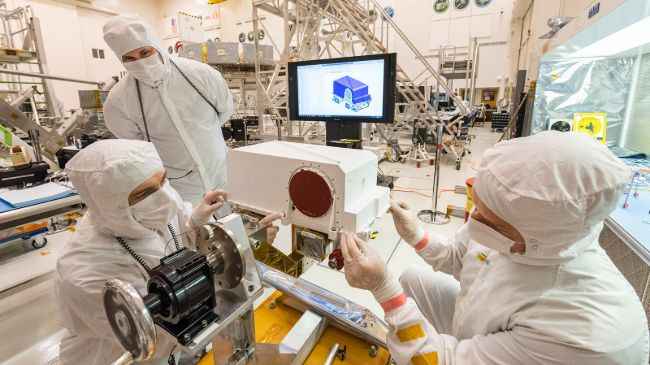NASA Mars 2020 spacecraft gets high-res cameras to enable unprecedented 3D imaging
In the latest NASA Mars mission development, the space agency installed a couple of high-resolution cameras on its Mars-bound spacecraft, Mars 2020. Named Mastcam-Z, the pair of cameras is a multispectral, stereoscopic imaging instrument that, according to NASA, will enhance the Mars 2020 rover's driving and core-sampling capabilities. In other words, it’s a good deal better than the average 16-megapixel shooter on your smartphone.
With a picture of the spacecraft being tended to by a trio of engineers in the Spacecraft Assembly Facility's High Bay 1 clean room at the Jet Propulsion Laboratory in Pasadena, California, NASA explained that the two Mastcam-Z high-definition cameras are kept covered until it’s time for flight. The cover on top of the camera units reads “Remove before flight”. The Mastcam-Z cameras sit along with the head block of the remote sensing mast (RSM).

Look at the wrapped camera below the red cap
“Mastcam-Z will be the first Mars color camera that can zoom, enabling 3D images at unprecedented resolution,” commented Mastcam-Z Principal Investigator Jim Bell of Arizona State University in Tempe. “With a resolution of three-hundredths of an inch [0.8 millimeters] in front of the rover and less than one-and-a-half inches [38 millimeters] from over 330 feet [100 meters] away - Mastcam-Z images will play a key role in selecting the best possible samples to return from Jezero Crater.”
One of the first few activities Mars 2020 will perform after landing on the Red Planet is raising the RSM to activate its optics and testing equipment. According to NASA, “Mars 2020 will be the first spacecraft to in the history of planetary exploration with the ability to accurately retarget its point of touchdown during the landing sequence”. The spacecraft will also carry with it a sample-caching mechanism, which will be used to collect Martian rock and soil samples and store them on the Martian surface until a future mission takes them back to Earth for deeper study.
Inline image courtesy: NASA
from Latest Technology News http://bit.ly/2IrR4Qr

No comments